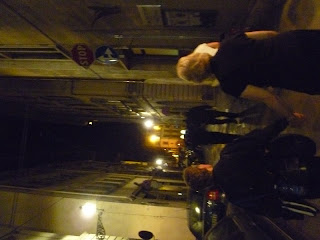One thing we have learned on this side of the big pond is that Italian Internet and cell phone service may be, as they say, spotty. You'll read a comment by Wilmer Henninger on that matter a little later. At any rate, I am happy to say that last night and this morning a number of photos, taken over the last three days, made their way through the air and into my inbox last night and this morning. And so, we share them with you, hoping to get them all correctly captioned and in the right order.
You will recall that on Saturday night, the Market Square Singers sang in Lucca after their visit to Florence. Let us start, then, with photos of their morning visit to Florence, sent by Wilmer and Lee Gayman.
You will recall that on Saturday night, the Market Square Singers sang in Lucca after their visit to Florence. Let us start, then, with photos of their morning visit to Florence, sent by Wilmer and Lee Gayman.
 |
| Leaving the church in Florence where the concert was held, and passing yet another beautiful church. (LG) Singers Chris and Judy enjoy the stroll back to the hotel. (Photo by Molly Shortridge) |
Michaelangelo's "David" is one of the great attractions of Florence. Here, a replica stands outside the City Hall.
"This is actually close to the original intended location for the real David. An exterior, not interior, location was chosen, so, expecting that it would be viewed from a distance, Michaelangelo made David's hands and feet abnormally large." (WH)
|
 |
| "Our ticket to the Florence Accademia to see 'David.' Unfortunately, no photography is permitted inside. I didn't attempt a forbidden photo, fearing discovery and expulsion." (WH) |
 |
| "On our way to our final concert in Lucca, we pass one of Lucca's most popular restaurants. It made me sad." (WH) |
Wil, I suppose a citizen of Lucca would be unhappy to run across an Olive Garden in the United States!
 |
| "We must park outside the city wall and walk into the city through a portal." (WH) |
 |
| "A lovely walk takes us to our concert church." (WH) |
 |
Finally, the group arrives at the Church of Santa Maria Corteorlandini, entering, I believe, by the medieval side door. The front of the church now has a Baroque façade.
 |
| "Unassuming from the outside, this Lucca church was where we gave our final concert to what was likely our most enthusiastic audience." (LG) |
 |
| "Here Jim, Wil, and Karen enter the church." (LG) |
 |
| Dan stops to see if they've put his name on the poster yet. |
On Sunday, the Market Square Singers left for Rome for a few days of concert-free touring.
 |
| "Some of The Pines of Rome on the way to one of The Fountains of Rome." (WH) |
The Roman Colosseum is perhaps the most famous of all the sights in Rome. It is the largest ever built in the Roman Empire. It is considered one of the greatest works of Roman architecture and Roman engineering. This amphitheater could seat 50,000 spectators in its heyday. Now it remains partially ruined because of damage caused by devastating earthquakes and stone-robbers. Still, it's a breath-taking symbol of Imperial Rome. Wil Hemminger took this picture.
 |
| "Tour guide Luigi gives advice to Karen on what sites and sights to see." (WH) |
Cities and municipalities throughout the Roman Empire emulated this model and funded aqueducts as objects of public interest and civic pride, "an expensive yet necessary luxury to which all could, and did, aspire."
Most Roman aqueducts proved reliable, and durable; some were maintained into the early modern era, and a few are still partly in use. Here's one Wil spotted in Rome.
 |
| "Ruins of an aqueduct on the Palatine Hill." (WH) |
Here's a prettier example left by the Romans in southern France, nearly intact today after 20 centuries.
This brings to an end our entry for today. Perhaps some photos will arrive tomorrow, when the Market Square Singers will head home. No matter when we receive the photos, we hope to conclude this blog and bring the story full circle.








To John and all contributors and singers
ReplyDeleteIt's been a great trip even through my computer!
Thanks for all your great pictures. I hope to hear (and see?) a lot more after you return to HBG.
Dottie H.